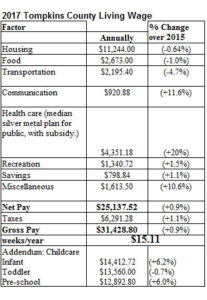Tompkins County Living Wage Biennial Update Announced Today – $15.11/hour
(Ithaca) Alternatives Federal Credit Union (AFCU) today announced its new Living Wage calculations for a single individual living in Tompkins County based on 2016 living/rental costs. This amounts to $15.11/hour.
 The Tompkins County Workers’ Center (TCWC) applauds AFCU’s commitment to paying its own workers a Living Wage and providing the research that helps establish the foundation for a more fair economy in Tompkins County.
The Tompkins County Workers’ Center (TCWC) applauds AFCU’s commitment to paying its own workers a Living Wage and providing the research that helps establish the foundation for a more fair economy in Tompkins County.
Facebook Live Video of Press Conference
The new Tompkins County Living Wage, way beyond what many people are actually paid, makes it crystal clear that Tompkins is really two counties. Too many people in Tompkins County do not have  an income that approaches the living wage – many earn as little as half that – and they, their families, and our overall quality of life suffer as a result. The preponderance of poverty-wage jobs in Tompkins County tears at the fabric of our community and increases the tax burden on all families.
an income that approaches the living wage – many earn as little as half that – and they, their families, and our overall quality of life suffer as a result. The preponderance of poverty-wage jobs in Tompkins County tears at the fabric of our community and increases the tax burden on all families.
That is why it is critical now more than ever that the Living Wage must be the Minimum Wage (see FAQ here). We can’t wait for Washington or Albany to do it for us. To meet that challenge, the Workers’ Center is in the midst of a campaign to enact a comprehensive living wage law for all Tompkins County workers.
Some will say, “It’s too complicated†or “It’s too difficult†or “It will never happen.†But you know what is really complicated and difficult? It is trying to live and even perhaps being a good parent on $9.70/hour (the present minimum wage in upstate NY).
This year, Alternatives Federal Credit Union, the Tompkins County Workers’ Center, and the Alternatives Fund of Ithaca conducted the first-ever study of the Certified Living Wage Employer (CLWE) workforce. Since the CLWE program began in 2006, we have had considerable information about the businesses that choose to pay all employees a Living Wage and get certified, but have had no real data about who makes up the workforce. This study is the beginning of learning about these workers and learning whether our Living Wage work has made a difference. It has.

August 21, 2017 @ 10:56 am
The new livable wage of $15.11 is for employers that do not offer health insurance at a set cost, correct?
IF the employer offers health insurance at a low cost, is the livable wage different? If so, what is it?
Thanks.
August 21, 2017 @ 4:20 pm
Hi Maryl (and all interested folks),
You’ve hit the nail on the head with the issues related to health care. Insurance is such a cost burden for workers and employers who offer it . The Living Wage of $15.11 is indeed for anyone who has no help from their employer with insurance. It is based on the income someone has to earn in order for their income-dependent health insurance subsidy to help them buy insurance available to the public on NY State of Health with $0 left over and $0 owed and also afford all the other costs of Living (housing, food, etc.).
If someone has an employer contribution to insurance available, the wage goes down based on how much the employee would have to spend for coverage. That’s why Alternatives Federal Credit Union’s study also shows an example rate of $13.90, which is what somebody has to earn to afford the much lower expense of insurance with AFCU’s employer contribution.
We’ll be sending out detailed information on the total Living Wage if the employer pays 100% of premium, and the spread in between, to Certified Living Wage Employers soon, and putting that info up on the certification part of our website here.
TCWC’s office manager, Rob Brown, is available for Certified Living Wage questions at 607-269-0409 or tcwrh@tcworkerscenter.org.